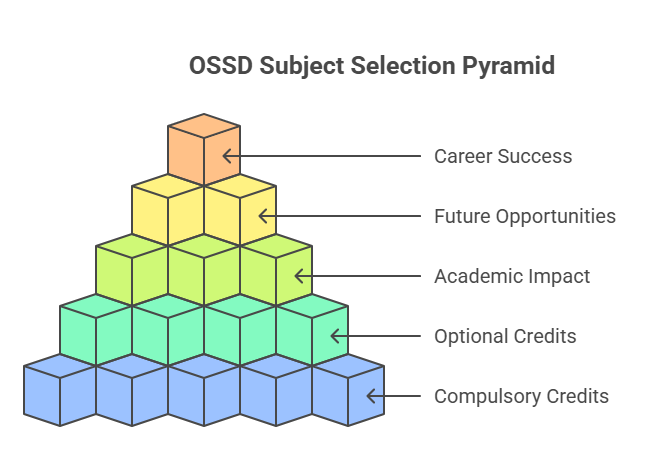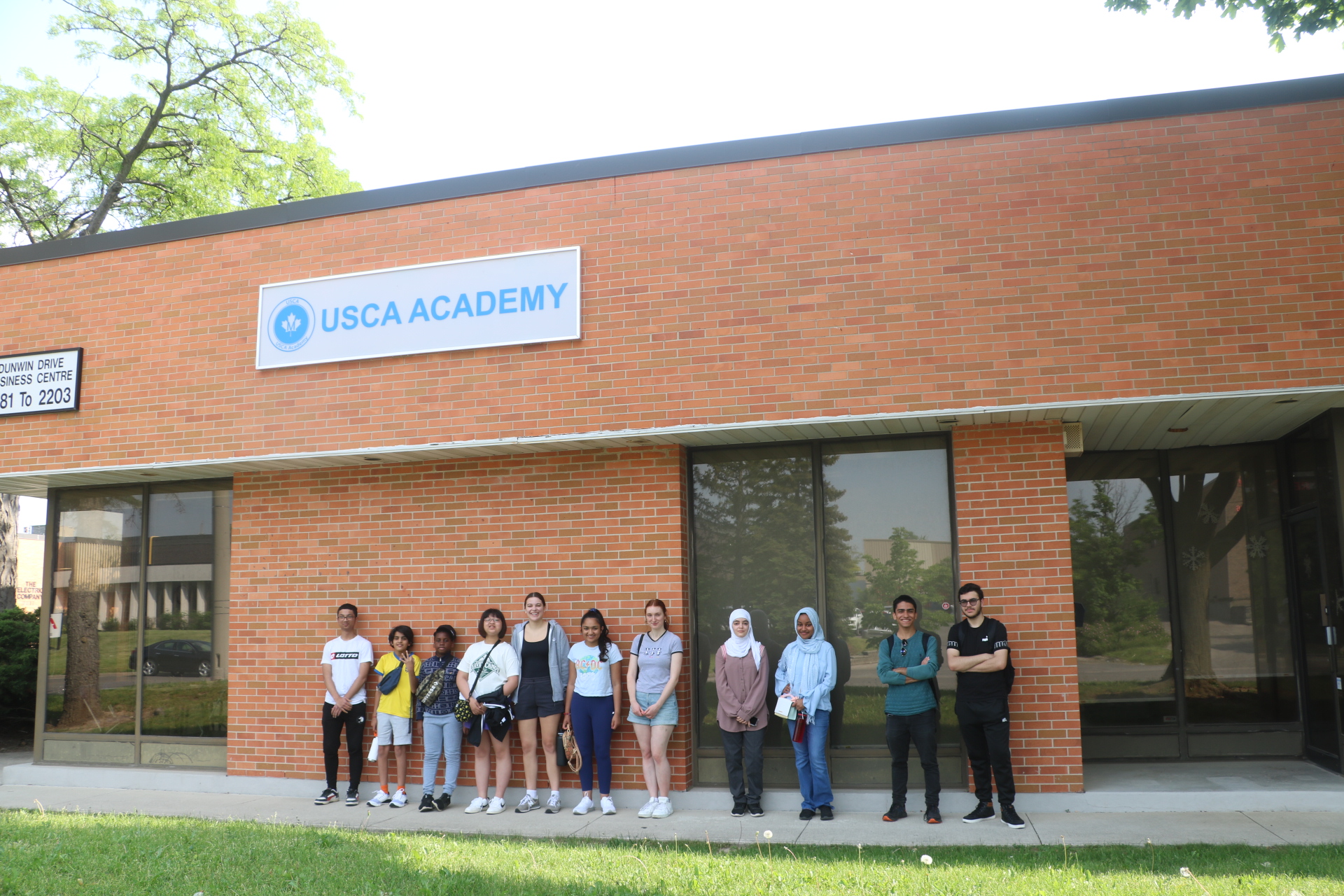Ontario, Canada, issues the Ontario Secondary School Diploma (OSSD) to any student fulfilling all the secondary school criteria. Besides allowing you to graduate in Ontario, the diploma is recognised by schools and employers both in Canada and worldwide. Accepted internationally, a pass in the Ontario Secondary School Diploma gives students access to many universities and careers.
Students who want the OSSD must accrue the required number of credits in subjects such as English, Mathematics, Science, Canadian History and additional groups. In addition to the required subjects, students can pick from business studies, computer science, arts, technological education and other OSSD subjects that match what they want to study and their future plans.
Students must differentiate between compulsory and optional OSSD subjects when making their high school course picks.
OSSD Subjects: Requirements, Structure, and Choosing the Right Courses.
It is the Ministry of Education in Ontario that awards the Ontario Secondary School Diploma (OSSD) as the high school graduation certificate. It is evidence that a student has satisfactorily completed the education that the province controls. To earn the OSSD, students must complete mandatory and optional credits, spend 40 hours working in the community and do well on the Ontario Secondary School Literacy Test (OSSLT) or its equivalent.
The OSSD is designed to make certain that graduates have the skills needed to live and work independently, even if they continue with their education, select a trade or start working right away. Not only does the program teach students the essentials in English, Mathematics and Science, but it also helps them learn crucial skills for working and communicating well.
If students have achieved the requirements for the OSSD, they are considered ready for education, employment or other personal projects. Because the diploma is respected in Canada and abroad, it gives young people strong credentials to build on for later study or work everywhere. The OSSD subjects list includes a wide range of compulsory and elective courses across categories such as English, Mathematics, Sciences, Business, Arts, Technological Education, Social Sciences, and Cooperative Education.
Importance of Subject Selection in the OSSD

OSSD subjects requirements include completing 17 compulsory credits in key areas like English, Math, Science, and Canadian Studies, plus 12 optional credits to meet the 30-credit graduation standard.
- Choosing subjects affects how a student feels at school and their grades.
- Which subjects you pick can determine whether you are accepted into certain colleges, universities or apprenticeship programs.
- Taking approved courses guarantees you meet the requirements for your after-graduation program.
- Selecting subjects close to what you enjoy most and are good at encourages you and helps you do well.
- Make a plan and follow it, so you will not need to do summer school or repeat a course.
- A mix of essential OSSD subjects and those you choose gives you a range of skills.
- Choosing particular subjects wisely can help you find scholarships and take part in unique programs such as IB, AP or SHSM.
- Learning about the courses offered in OSSD helps students decide which path to follow for future career success.
Overview of OSSD Subject Structure
The OSSD subjects and curriculum encompass a balanced mix of compulsory and optional courses designed to provide students with a comprehensive education that develops academic knowledge, critical thinking, and practical skills across various disciplines, preparing them for post-secondary education and career success.
- 17 compulsory credits: These are mandatory courses that provide foundational knowledge across various disciplines.
- 12 optional credits: These allow students to explore areas of personal interest or to specialize in subjects related to their intended post-secondary pathways.
In addition to the credit requirements, students must also
- Complete 40 hours of community involvement activities.
- Successfully pass the Ontario Secondary School Literacy Test (OSSLT) or the Ontario Secondary School Literacy Course (OSSLC)
- Complete 2 online learning credits.
Compulsory OSSD Subjects
OSSD subject requirements include a total of 30 credits, 17 compulsory and 12 optional along with successful completion of the Ontario Secondary School Literacy Test (OSSLT) and 40 hours of community service. OSSD optional subjects are elective courses that students can choose beyond the compulsory requirements, allowing them to explore interests in areas like Business Studies, Computer Studies, Technological Education, Social Sciences, Arts, and Cooperative Education to customize their learning experience and support future career or academic goals.
The 17 compulsory credits are distributed as follows:
- 4 credits in English (1 credit per grade)
- 3 credits in mathematics (Grade 9, Grade 10 and 1 credit in Grade 11 or 12)
- 2 credits in science
- 1 credit in technological education (Grade 9 or Grade 10)
- 1 credit in Canadian history (Grade 10)
- 1 credit in Canadian geography (Grade 9)
- 1 credit in the arts
- 1 credit in health and physical education
- 1 credit in French as a second language
- 0.5 credit in career studies
- 0.5 credit in civics and citizenship
- 1 credit from the STEM-related course group
Additionally, students must earn one credit from each of the following groups:
- Group 1: An additional credit in English, French as a Second Language, a Native language, classical or international language, social sciences and humanities, Canadian and world studies, guidance and career education, or cooperative education.
- Group 2: An additional credit in health and physical education, the arts, business studies, French as a Second Language, or cooperative education.
- Group 3: An additional credit in science (Grade 11 or 12), technological education, French as a Second Language, computer studies, or cooperative education
Topics Found in Popular Courses
Top international schools in Canada include Upper Canada College, St. George’s School, and Appleby College, known for their world-class curricula and diverse student communities.
- Business Studies
Includes courses in:- Accounting
- Marketing
- Entrepreneurship
- Finance
These subjects are ideal for students interested in entering the business sector.
- Computer Studies
Covers:- Programming
- Information Technology
- Fundamentals of Computer Science
- Technological Education
Offers hands-on learning in:- Construction Technology
- Transportation Technology
- Communication Technology
- Social Sciences and Humanities
Encompasses subjects like:- Psychology
- Sociology
- Family Studies
These courses help students understand cultures, develop critical thinking, and assume social responsibility.
- Additional Sciences or Arts(optional electives)
Students may opt for:- Extra Science courses
- Visual or Performing Arts
- Cooperative Education (Co-op)
- Allows students to earn academic credits through real-world work experiences.
- Encourages skill development by applying classroom knowledge in practical settings.
How Extra Instructional Activities Can Help Students Prepare for Future Paths
Good private high schools are independent institutions known for their strong academic programs, low student-to-teacher ratios, enriched extracurricular offerings, and personalised college or university preparation in a supportive learning environment. Selecting appropriate electives can help a student prepare well for either further studies or a job.
Students choosing commerce may gain from choosing some elective courses in accounting or marketing, and engineering students might find that advanced mathematics, physics or technology-related courses will help them. Besides expanding knowledge, electives develop your communication, problem-solving and time skills. When students pick optional OSSD courses, they become ready for college or university and can take a closer look at subjects that appeal to them.
Subjects Offered in the OSSD to International Students
While international students who take the OSSD online or at partner schools can choose from many subjects, what is available might depend on the institution. Because many schools now offer core subjects and popular electives online, flexibility and accessibility are available anywhere in the world.
Nevertheless, some special classes like arts and technology can have obstacles because of their platform. Most programs include language support and ESL helps foreign pupils do well in school subjects and communication. International students are advised to confirm the availability of courses, both for Grade 11 and 12, so they fulfill OSSD and their study plans.
The Process of Selecting Your Program and Choosing Personnel
Ontario also makes available specific pathways that add value to the regular subjects students can take. The IB program ensures students follow a worldwide curriculum designed for high academic achievement. Students in AP can study and test at a college level while attending high school.
Education for industry can be found in Specialist High Skills Majors (SHSM) which provide certifications and courses in health care, ICT, art and other fields. Students from all over the world can use Cooperative Education to meet their credits for their OSSD and develop working experience in areas they are interested in. Students who join these programs draw more attention in university applications and understand more about their future work settings.
Overview of How the Course Codes Work
It may seem hard to grasp Ontario’s course coding system initially, but knowing it matters a lot when you’re choosing your classes. You can identify the subject, grade level and type by looking at the six characters in a course code, for instance, ENG3U (the course profile for English Grade 11, university track). Aligned with many college and workplace ambitions, the types of courses are Academic (D), Applied (P), University (U), College (C), Workplace (E) and Open (O). Most often, the sixth character is reserved for administrative tasks. By reviewing these codes, students find out if a course matches the requirements for advanced classes or university admissions.
Conclusion
The Ontario Secondary School Diploma (OSSD) offers a flexible and comprehensive educational framework that empowers students to take ownership of their academic journey. With a rich selection of compulsory and optional subjects, diverse course streams, and access to specialized programs like IB, AP, SHSM, and Cooperative Education, students can customize their learning experience to align with their strengths, interests, and future goals.
Everyone pursuing the OSSD gains a lot from understanding the layout and decisions made in the curriculum. Recognizing that choosing subjects is necessary apart from completing graduation, to achieve outcomes for university, college or trade schools or just explore personal interests is important. Taking time to choose classes carefully ensures students are motivated, pick up important skills and have a good chance of doing well after high school.
With the OSSD, learners have a solid education base and the ability to follow their dreams for higher study, work or living abroad.
Frequently Asked Question About OSSD Subjects
1. Can I pick different subjects after choosing them in high school?
Usually, students can adjust their academic schedule within the first weeks of the semester. Guidance counsellors are there to help with the results of any changes.
2. Can any subjects be learned at summer school?
Different schools have summer programs where students can take both needed and optional subjects to either get credits faster or take them again if needed.
3. Is the course curriculum for OSSDs uniform at every school in Ontario?
Although the Ministry of Education sets the rules for graduation, courses might be available differently and delivered variously in each school.
4. Is it possible to take OSSD subjects over the internet?
Absolutely. Much of the Ontario curriculum can be completed online by students who live abroad or have conflicts with their schedules.









